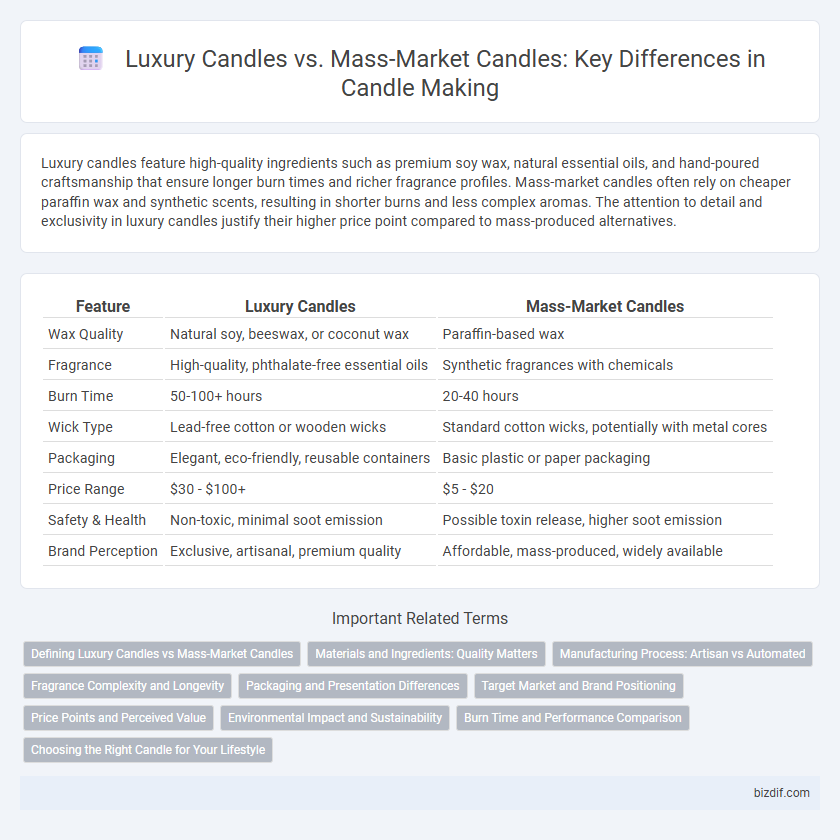Luxury candles feature high-quality ingredients such as premium soy wax, natural essential oils, and hand-poured craftsmanship that ensure longer burn times and richer fragrance profiles. Mass-market candles often rely on cheaper paraffin wax and synthetic scents, resulting in shorter burns and less complex aromas. The attention to detail and exclusivity in luxury candles justify their higher price point compared to mass-produced alternatives.
Table of Comparison
| Feature | Luxury Candles | Mass-Market Candles |
|---|---|---|
| Wax Quality | Natural soy, beeswax, or coconut wax | Paraffin-based wax |
| Fragrance | High-quality, phthalate-free essential oils | Synthetic fragrances with chemicals |
| Burn Time | 50-100+ hours | 20-40 hours |
| Wick Type | Lead-free cotton or wooden wicks | Standard cotton wicks, potentially with metal cores |
| Packaging | Elegant, eco-friendly, reusable containers | Basic plastic or paper packaging |
| Price Range | $30 - $100+ | $5 - $20 |
| Safety & Health | Non-toxic, minimal soot emission | Possible toxin release, higher soot emission |
| Brand Perception | Exclusive, artisanal, premium quality | Affordable, mass-produced, widely available |
Defining Luxury Candles vs Mass-Market Candles
Luxury candles distinguish themselves through high-quality ingredients such as natural soy or beeswax, premium fragrance oils, and handcrafted packaging that enhances their exclusivity. Mass-market candles typically use paraffin wax, synthetic scents, and standardized production methods aimed at affordability and wide availability. The defining factors include ingredient purity, scent complexity, burn time, and artisanal craftsmanship, which contribute to luxury candles' superior performance and sensory experience.
Materials and Ingredients: Quality Matters
Luxury candles use high-quality, natural ingredients such as soy, beeswax, or coconut wax, combined with premium essential oils to ensure a clean, longer-lasting burn and richer fragrance. Mass-market candles often rely on paraffin wax and synthetic fragrances, which can produce soot and a shorter burn time. The choice of materials directly impacts the candle's aroma, safety, and overall user experience, highlighting the importance of ingredient transparency and quality in luxury options.
Manufacturing Process: Artisan vs Automated
Luxury candles are crafted through artisan manufacturing processes that emphasize hand-poured wax, high-quality natural ingredients, and meticulous attention to detail, resulting in unique scents and refined finishes. Mass-market candles rely on automated production lines, utilizing synthetic materials and bulk manufacturing techniques to achieve high volume and lower costs. This distinction in manufacturing affects the overall fragrance complexity, burn quality, and aesthetic appeal of the candles.
Fragrance Complexity and Longevity
Luxury candles feature intricate fragrance blends composed of high-quality essential oils and rare aromatic compounds, resulting in a richer and more nuanced scent profile. They offer superior longevity, with scents that gradually evolve and maintain their intensity over extended burn times. Mass-market candles often rely on synthetic fragrances that produce simpler scents with shorter-lasting aromas and a tendency to fade quickly.
Packaging and Presentation Differences
Luxury candles often feature handcrafted packaging with high-quality materials such as glass containers, metal lids, and intricate labels, enhancing their aesthetic appeal and perceived value. Mass-market candles typically use simpler, standardized packaging made from plastic or thin glass with basic printed labels to reduce costs and increase production speed. The presentation of luxury candles caters to an experience-focused consumer, emphasizing elegance and exclusivity, whereas mass-market options prioritize functionality and affordability.
Target Market and Brand Positioning
Luxury candles target affluent consumers seeking exclusive scents and premium craftsmanship, often emphasizing artisanal production and high-quality ingredients like natural soy or beeswax. Mass-market candles appeal to budget-conscious buyers prioritizing affordability and variety, typically produced at scale with synthetic fragrances and paraffin wax. Brand positioning for luxury candles centers on exclusivity, elegance, and sensory experience, while mass-market brands highlight accessibility, convenience, and broad appeal.
Price Points and Perceived Value
Luxury candles typically feature high-quality ingredients such as natural soy or beeswax, unique fragrances, and artisan craftsmanship, resulting in price points ranging from $40 to $100 or more per candle. Mass-market candles, often made with paraffin wax and synthetic scents, are priced significantly lower, usually between $5 and $20, catering to budget-conscious consumers. The perceived value of luxury candles is enhanced by exclusive branding and longer burn times, creating a premium experience that justifies the higher cost compared to mass-produced alternatives.
Environmental Impact and Sustainability
Luxury candles typically use high-quality, natural ingredients like soy or beeswax and essential oils, resulting in a lower environmental impact due to their biodegradable materials and cleaner burn. Mass-market candles often contain paraffin wax derived from petroleum, emitting harmful toxins and contributing to environmental pollution. Sustainable luxury candles prioritize eco-friendly packaging and ethical sourcing, promoting a reduced carbon footprint compared to mass-produced alternatives.
Burn Time and Performance Comparison
Luxury candles typically offer longer burn times due to higher-quality wax blends and premium wicks that ensure even melting and minimal soot production. Mass-market candles often use lower-grade materials, resulting in shorter burn durations and inconsistent performance with uneven burning and faster wax consumption. Consumers seeking sustained fragrance release and clean burning usually prefer luxury candles despite their higher price point.
Choosing the Right Candle for Your Lifestyle
Luxury candles often feature high-quality natural waxes like soy or beeswax, premium essential oils, and handcrafted designs that provide longer burn times and richer scents, making them ideal for those seeking an elevated sensory experience and ambient decor. Mass-market candles typically use paraffin wax and synthetic fragrances, offering affordability and widespread availability but with shorter burn durations and less complex aromas, suiting practical daily use and budget-conscious shoppers. Selecting the right candle depends on lifestyle preferences, whether valuing luxury and sustainability or convenience and cost-efficiency.
Luxury candles vs Mass-market candles Infographic

 bizdif.com
bizdif.com